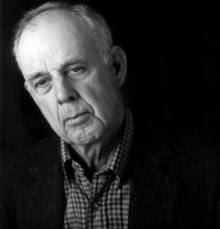At Hutchmoot 2011, Andrew Peterson and I hosted a session about story and place. This post is the first half of the talk I gave at that session. The second half, which concerns itself mostly with Flannery O’Connor and a little bit of Marilynne Robinson, will come in the not-too-distant future.
In The Myth of the Eternal Return, Mircea Eliade tells the true story of a folklorist who schlepped around Romania collecting ballads and folk stories in the 1930s. He was especially taken by a ballad about a young shepherd who had the misfortune of having a mountain fairy fall in love with him. He was already betrothed to a village girl, however, and had no interest in the fairy. The fairy was insanely jealous, but the young man would not be moved; he loved his village girl and was determined to marry her. So the day before his wedding, the fairy pushed him off a cliff.
Shepherds from the village found him at the bottom of the ravine and carried his broken, lifeless body back to the village. When his fiancée saw them, she burst into a long, emotional lament full of mythological references reaching back before the beginnings of history, as if her sorrow were the oldest sorrow in the world. That lamentation forms the main body of the ballad.
Part of the folklorist’s job, of course, is to try to figure out where such stories and ballads come from. This one, the villagers told him, was very old, passed down for who knew how many generations. But the folklorist kept asking, and somebody remembered that the fiancée in the ballad—the one who sang the original lament—was still living in the next village up the road. So maybe it wasn’t as old as all that, the villagers agreed.
“Wait a minute,” I can picture the folklorist saying. “You’re saying that the whole thing with the mountain fairy happened just up the road?”
“That’s right.”
“And it happened recently enough that the fiancée in the story is still alive?”
“That’s right,” said the villagers. “She’s the one you ought to talk to if you want to know more about the ballad.”
So the folklorist did. He traveled to the next village and there he found a woman in her late fifties or early sixties who said, yes, she was the fiancée from the ballad.
“So what happened?” the folklorist asked.
“Well, it was about forty years ago,” the woman said. “I was engaged to be married, but the day before the wedding, my fiancé fell off a cliff and died.”
“Fell off a cliff?” the folklorist said. “You mean was pushed off a cliff? By a mountain fairy?”
“Oh, I don’t know about any fairy,” the woman said. “I’ve heard about her in the ballad, but before that, all I knew was that he fell off a cliff and died the day before we were supposed to get married.”
“But what about the long, soulful lament with all the mythological references?”
“I mourned him,” the woman said. “It was a sad thing, losing a fiancé the day before the wedding. But I couldn’t have made up all that business that’s in the ballad. I was a simple village girl. I did the regular mourning that you would expect, but then I tried to get on with my life.”
After talking with the woman, the folklorist headed back to the first village. “Hey, I talked to the woman in the ballad,” he told the villagers. “She said there wasn’t any fairy. She said her fiancé just had an accidental fall the day before their wedding.”
“Pitiful, isn’t it?” said one of the villagers, shaking his head and clucking his tongue. “The poor woman was so crazed with grief that she couldn’t even remember the fairy who pushed her fiancé to a horrible death.”
There are about fifteen things I love about that story. One of the biggest is the villagers’ vision of the world they inhabited. “You think these are podunk villages?” they seemed to be saying to the folklorist. “Oh no, friend, there are big things afoot here in these villages—more than meets the eye. And these peasants here—they’re full participants in the eternal.” They believed that their mundane world interpenetrated with a world of transcendence.
In his Port William novels, Wendell Berry is doing something very similar to what those Romanian villagers were doing with their story of the jilted fairy. Berry writes of a forgotten little place, and in so doing demonstrates that there are vast things afoot—much more than meets the eye.
Certain religious traditions speak of “thin places”—places on earth where the veil between the seen and the unseen is particularly thin, where mortals are more likely to see the goings-on of the spirit world. Perhaps those Romanians viewed the fairy’s cliff as a thin place. The point of Wendell Berry’s whole project, it seems to me, is that every place, if you settle down and look at it, if you pay attention, is a thin place. After he finished his education in California, Wendell Berry moved back to the Kentucky County where both sides of his family had lived for five generations, and he said, “I’m going to keep looking at and listening to this place—this landscape, these voices, these folkways, these old stories—until it gives up its secrets.”
I’m not trying to be especially mystical here. I think I’m talking about a pretty straightforward truth that Christians claim to believe. C.S. Lewis put it this way in an oft-quoted passage from “The Weight of Glory”:
It is a serious thing to remember that the dullest and most uninteresting person you talk to may one day be a creature which, if you saw it now, you would be strongly tempted to worship, or else a horror and a corruption such as you now meet, if at all, only in a nightmare. All day long we are, in some degree, helping each other to one or other of these destinations. It is in the light of these overwhelming possibilities, it is with the awe and the circumspection proper to them, that we should conduct all our dealings with one another all friendships, all loves, all play, all politics.
There are no ordinary people.
You have never talked to a mere mortal.
Nations, cultures, arts, civilization these are mortal, and their life is to ours as the life of a gnat. But it is immortals whom we joke with, work with, marry, snub, and exploit immortal horrors or everlasting splendors.
The job of a storyteller, you might say, is to make thin places, places where we can see truer things than we normally see in the world around us. To do that requires that we pay attention to the world as we find it. We need to look and keep looking, confident that the truth will tell itself.
Big, eternal truths are pulsing and surging just below the surface of things, forever threatening to bust through. And the surface of things is scarcely adequate to conceal them.









Aaron Roughton
Jonathan, you asked me to remember September 23, 2011 as the day that I stepped off of the path of the preordained will of God for my life because I missed this talk at Hutchmoot. I thought you were just messing with me. After reading this, however, it turns out you were right.
But even in my horror at this revelation, I’m still really glad to see you posting things here again.
Jonathan Rogers
Still hoping you can return to the path, Aaron.
Tom Hoffman
Beautiful. Thank you. And welcome back.